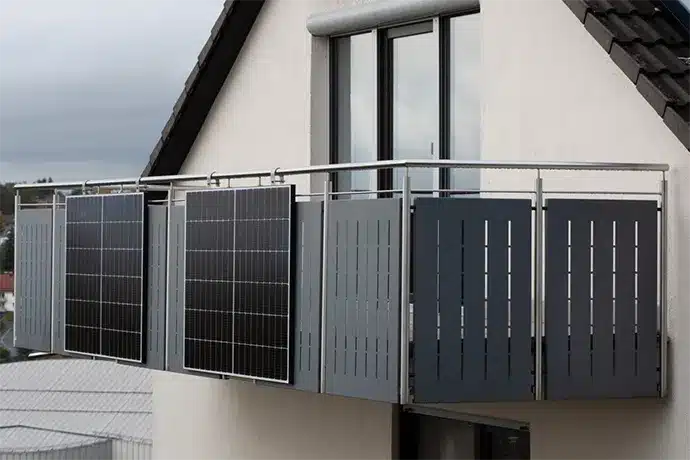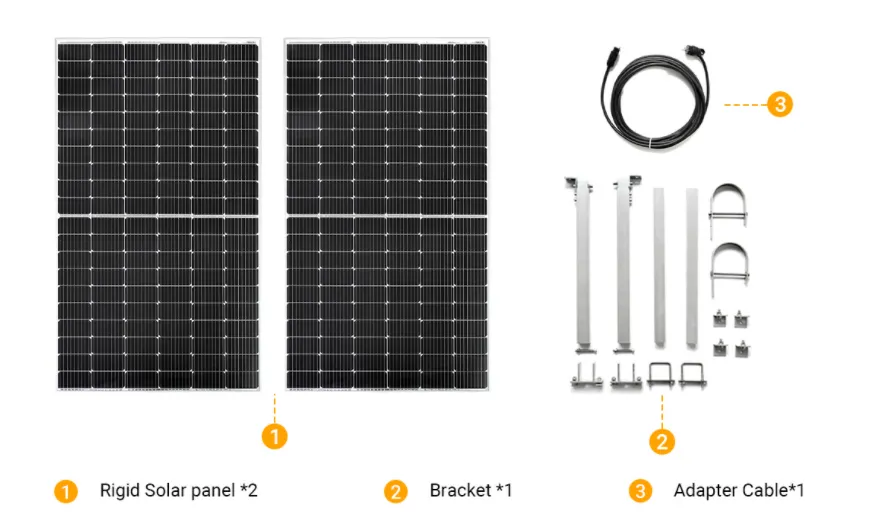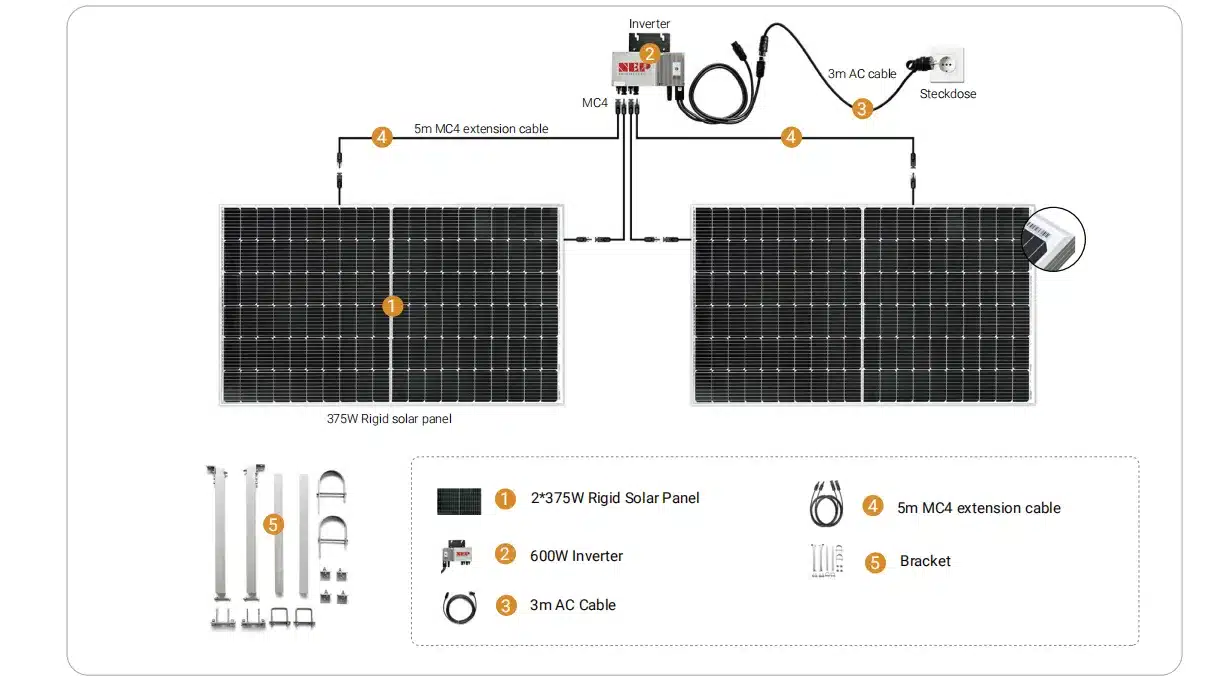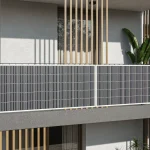Table of Contents
What is a balcony solar system?
In today’s era of energy scarcity, growing environmental awareness, and increasing demand for sustainable and renewable energy solutions, solar energy for personal home use is becoming increasingly popular.
A balcony solar system, also known as a mini solar system/plug-in solar panels, is a compact and efficient solution that utilizes the sun’s energy to generate its electricity.
Both balcony power plants and photovoltaic systems are solar power plants, which utilize the sun’s energy to generate electricity. However, the main differences are size and performance. Balcony power plants are typically smaller, with a maximum output of 800 watts (inverter output), and the electricity generated is usually not only used for personal consumption but also fed into the grid.
A balcony solar system consists of a series of smaller, more manageable balcony solar panels that are mounted on balcony railings or placed on racks. The panels are then connected to a microinverter that converts the direct current (DC) generated by the panels into alternating current (AC) suitable for home use.

Where can we use the balcony solar systems?
With today’s energy shortages and rising electricity prices, everyone is looking to utilize cleaner energy sources to reduce traditional energy consumption, and photovoltaic systems are the way to go.
Many homes are choosing to install solar panels on their roofs and on the ground to generate electricity from small-scale photovoltaic systems. Millions of renters and apartment owners are overwhelmed by the inability to utilize solar energy because they don’t have a suitable roof for installation.
As a result, balcony solar systems were created. Simple, easy-to-install balcony systems can meet the needs of a large number of apartment dwellers and individual homes, and not only can they reduce installation costs by a large amount, but they can also achieve self-sufficiency in electricity.
What accessories are included in the balcony solar systems?
3.1 Solar panels for balconies
The balcony solar panel is the core component of the balcony solar system, which absorbs sunlight, converts the light energy into direct current (DC), and then converts it into alternating current (AC) through a micro-inverter, which is usually installed on the balcony.
Solar panels for balcony systems are smaller, lighter, and take up less space, suitable for family homes, apartments etc.
3.2 Microinverter
Grid-connected microinverter converts the DC power generated by the solar panels into AC power output to supply power to the home, using NEP microinverter, which can be easily connected and efficiently used.
3.3 Mounting Bracket
The purpose of the mounting bracket is to fix the solar panels firmly on the balcony and adjust the angle of sunlight to get more light and generate more electricity.
The Sungold bracket is strong and durable, ensuring that there is no need to replace parts within a few years, and can be adjusted to the right angle according to the local sunlight radiation, for example, the optimal angle for the installation of the solar energy system for balcony in Germany is 35°.
3.4 Solar cables and connections
The wire plugs the system into the socket and connects it to the home circuit, and the AC input from the system directly powers the household appliances. The balcony system is a plug-and-play device. It can be used directly by just inserting the plug into the home, which is very convenient.

How to assemble and connect balcony solar system?
Take the 600W balcony solar system as an example, the whole system consists of 2 pieces of 375w glass solar panels, a 600w micro inverter, a mounting bracket, a 5m MC4 extension cable, 3m grid connection cable.
As shown in the picture below:

What are the benefits of installing a balcony solar system?
5.1 Reduction of electricity costs
The balcony system is plug-and-play, well suited to individual household needs, unaffected by rising electricity costs, reduces reliance on the grid, and in the case of apartment tenants, the system can be moved out of the apartment at the same time as the move, significantly reducing costs.
5.2 Eco-friendly
5.3 Independent of grid supply
Independent of grid supply, reducing dependence on the public grid.
Frequently asked questions about balcony solar panels
1. Which system is the best? Can a landlord forbid the installation solar panels on a balcony?
The “best” solar system depends on individual needs. Balcony power plants, especially designed for tenants, are a compact option with limited space and easy installation. Landlords generally do not prohibit small PV, which serves the national goal of environmental protection.
Note:Balcony electrical systems must meet building codes, be visually unobtrusive, easily removable, and professionally installed without detracting from the property.
Tip:If it is not specified in the lease, it is still advisable to communicate with the landlord to avoid future conflicts.
Note:A license is required for installation on the walls, roof or balcony of the house.
2. Does it make sense to install a balcony solar system in a rental apartment?
Balcony solar panels are a worthwhile investment for both tenants and owners of rental homes. Each balcony power plant, regardless of output, must be registered with the local grid operator.
As a property owner, you can invest in solar energy for the long term, increase the value of your property and benefit from independence. Tenants can lower their own electricity bills and use environmentally friendly.
3. Is there a subsidy program for balcony solar systems?
If not there is a Germany wide support program for balcony power plants. Funding for plug-in solar systems is regionally dependent and varies from state to state and municipality to municipality in terms of funding rates and conditions.
It is recommended to check with your local government or utility company about current subsidy
4. How many watts can I have on my balcony power plant?
Due to the current legal regulations in the field of solar energy systems, a balcony power plant may have an output of 600 watts in Germany at the moment. From January 1, 2024, this limit will be increased to 800 watts.
In order not to have to wait for this change, inverters with an output of 800 watts will be available and can be reduced to 600 watts.







